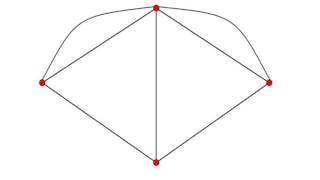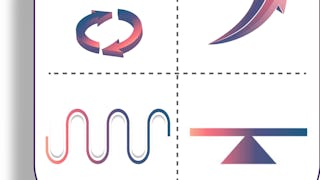We live in a complex world with diverse people, firms, and governments whose behaviors aggregate to produce novel, unexpected phenomena. We see political uprisings, market crashes, and a never ending array of social trends. How do we make sense of it? Models. Evidence shows that people who think with models consistently outperform those who don't. And, moreover people who think with lots of models outperform people who use only one. Why do models make us better thinkers? Models help us to better organize information - to make sense of that fire hose or hairball of data (choose your metaphor) available on the Internet. Models improve our abilities to make accurate forecasts. They help us make better decisions and adopt more effective strategies. They even can improve our ability to design institutions and procedures. In this class, I present a starter kit of models: I start with models of tipping points. I move on to cover models explain the wisdom of crowds, models that show why some countries are rich and some are poor, and models that help unpack the strategic decisions of firm and politicians.


(2,250 reviews)
What you'll learn
Understand how models make us better thinkers.
Learn how social scientists frame and interpret models.
Skills you'll gain
Details to know

Add to your LinkedIn profile
12 assignments
See how employees at top companies are mastering in-demand skills

There are 12 modules in this course
In these lectures, I describe some of the reasons why a person would want to take a modeling course. These reasons fall into four broad categories: 1)To be an intelligent citizen of the world 2) To be a clearer thinker 3) To understand and use data 4) To better decide, strategize, and design. There are two readings for this section. These should be read either after the first video or at the completion of all of the videos. We now jump directly into some models. We contrast two types of models that explain a single phenomenon, namely that people tend to live and interact with people who look, think, and act like themselves. After an introductory lecture, we cover famous models by Schelling and Granovetter that cover these phenomena. We follows those with a fun model about standing ovations that I wrote with my friend John Miller.
What's included
12 videos5 readings1 assignment
In this section, we explore the mysteries of aggregation, i.e. adding things up. We start by considering how numbers aggregate, focusing on the Central Limit Theorem. We then turn to adding up rules. We consider the Game of Life and one dimensional cellular automata models. Both models show how simple rules can combine to produce interesting phenomena. Last, we consider aggregating preferences. Here we see how individual preferences can be rational, but the aggregates need not be.There exist many great places on the web to read more about the Central Limit Theorem, the Binomial Distribution, Six Sigma, The Game of Life, and so on. I've included some links to get you started. The readings for cellular automata and for diverse preferences are short excerpts from my books Complex Adaptive Social Systems and The Difference Respectively.
What's included
12 videos2 readings1 assignment
In this section, we study various ways that social scientists model people. We study and contrast three different models. The rational actor approach, behavioral models, and rule based models . These lectures provide context for many of the models that follow. There's no specific reading for these lectures though I mention several books on behavioral economics that you may want to consider. Also, if you find the race to the bottom game interesting just type "Rosemary Nagel Race to the Bottom" into a search engine and you'll get several good links. You can also find good introductions to "Zero Intelligence Traders" by typing that in as well.
What's included
12 videos2 readings1 assignment
In this section, we cover tipping points. We focus on two models. A percolation model from physics that we apply to banks and a model of the spread of diseases. The disease model is more complicated so I break that into two parts. The first part focuses on the diffusion. The second part adds recovery. The readings for this section consist of two excerpts from the book I'm writing on models. One covers diffusion. The other covers tips. There is also a technical paper on tipping points that I've included in a link. I wrote it with PJ Lamberson and it will be published in the Quarterly Journal of Political Science. I've included this to provide you a glimpse of what technical social science papers look like. You don't need to read it in full, but I strongly recommend the introduction. It also contains a wonderful reference list.
What's included
13 videos2 readings1 assignment
In this section, we cover some models of problem solving to show the role that diversity plays in innovation. We see how diverse perspectives (problem representations) and heuristics enable groups of problem solvers to outperform individuals. We also introduce some new concepts like "rugged landscapes" and "local optima". In the last lecture, we'll see the awesome power of recombination and how it contributes to growth. The readings for this chapters consist on an excerpt from my book The Difference courtesy of Princeton University Press.
What's included
10 videos2 readings1 assignment
What's included
1 assignment
Models can help us to determine the nature of outcomes produced by a system: will the system produce an equilibrium, a cycle, randomness, or complexity? In this set of lectures, we cover Lyapunov Functions. These are a technique that will enable us to identify many systems that go to equilibrium. In addition, they enable us to put bounds on how quickly the equilibrium will be attained. In this set of lectures, we learn the formal definition of Lyapunov Functions and see how to apply them in a variety of settings. We also see where they don't apply and even study a problem where no one knows whether or not the system goes to equilibrium or not.
What's included
11 videos2 readings1 assignment
In this set of lectures, we cover path dependence. We do so using some very simple urn models. The most famous of which is the Polya Process. These models are very simple but they enable us to unpack the logic of what makes a process path dependent. We also relate path dependence to increasing returns and to tipping points. The reading for this lecture is a paper that I wrote that is published in the Quarterly Journal of Political Science
What's included
10 videos2 readings1 assignment
In this section, we first discuss randomness and its various sources. We then discuss how performance can depend on skill and luck, where luck is modeled as randomness. We then learn a basic random walk model, which we apply to the Efficient Market Hypothesis, the ideas that market prices contain all relevant information so that what's left is randomness. We conclude by discussing finite memory random walk model that can be used to model competition. The reading for this section is a paper on distinguishing skill from luck by Michael Mauboussin.
What's included
11 videos2 readings1 assignment
In this section, we cover the Prisoners' Dilemma, Collective Action Problems and Common Pool Resource Problems. We begin by discussion the Prisoners' Dilemma and showing how individual incentives can produce undesirable social outcomes. We then cover seven ways to produce cooperation. Five of these will be covered in the paper by Nowak and Sigmund listed below. We conclude by talking about collective action and common pool resource problems and how they require deep careful thinking to solve. There's a wonderful piece to read on this by the Nobel Prize winner Elinor Ostrom.
What's included
9 videos2 readings1 assignment
In this section, we cover replicator dynamics and Fisher's fundamental theorem. Replicator dynamics have been used to explain learning as well as evolution. Fisher's theorem demonstrates how the rate of adaptation increases with the amount of variation. We conclude by describing how to make sense of both Fisher's theorem and our results on six sigma and variation reduction. The readings for this section are very short. The second reading on Fisher's theorem is rather technical. Both are excerpts from Diversity and Complexity.
What's included
8 videos2 readings1 assignment
What's included
2 readings1 assignment
Instructor

Offered by
Explore more from Economics
 Status: Free Trial
Status: Free TrialDeep Teaching Solutions
 Status: Preview
Status: PreviewStanford University
 Status: Free Trial
Status: Free TrialUniversity of Virginia
 Status: Preview
Status: PreviewErasmus University Rotterdam
Why people choose Coursera for their career




Learner reviews
2,250 reviews
- 5 stars
82.18%
- 4 stars
14.26%
- 3 stars
2.13%
- 2 stars
0.53%
- 1 star
0.88%
Showing 3 of 2250
Reviewed on Jun 6, 2016
Wonderful course and equally wonderful instructor. I really like how Scott builds up from a very simple model and by explaining the intuition behind how we got the math, explains the maths.
Reviewed on Apr 7, 2018
This is a great introduction to the types and uses of models. The lectures are clear, and the examples given show good applicability to real world problems. Thanks for making it available!
Reviewed on Nov 18, 2019
This is a fantastic course that I would recommend to anyone interested in learning how to think better. It introduced me to many topics that i want to learn more about. Thank you, Professor Page!

Open new doors with Coursera Plus
Unlimited access to 10,000+ world-class courses, hands-on projects, and job-ready certificate programs - all included in your subscription
Advance your career with an online degree
Earn a degree from world-class universities - 100% online
Join over 3,400 global companies that choose Coursera for Business
Upskill your employees to excel in the digital economy
Frequently asked questions
To access the course materials, assignments and to earn a Certificate, you will need to purchase the Certificate experience when you enroll in a course. You can try a Free Trial instead, or apply for Financial Aid. The course may offer 'Full Course, No Certificate' instead. This option lets you see all course materials, submit required assessments, and get a final grade. This also means that you will not be able to purchase a Certificate experience.
When you purchase a Certificate you get access to all course materials, including graded assignments. Upon completing the course, your electronic Certificate will be added to your Accomplishments page - from there, you can print your Certificate or add it to your LinkedIn profile.
Yes. In select learning programs, you can apply for financial aid or a scholarship if you can’t afford the enrollment fee. If fin aid or scholarship is available for your learning program selection, you’ll find a link to apply on the description page.
More questions
Financial aid available,

